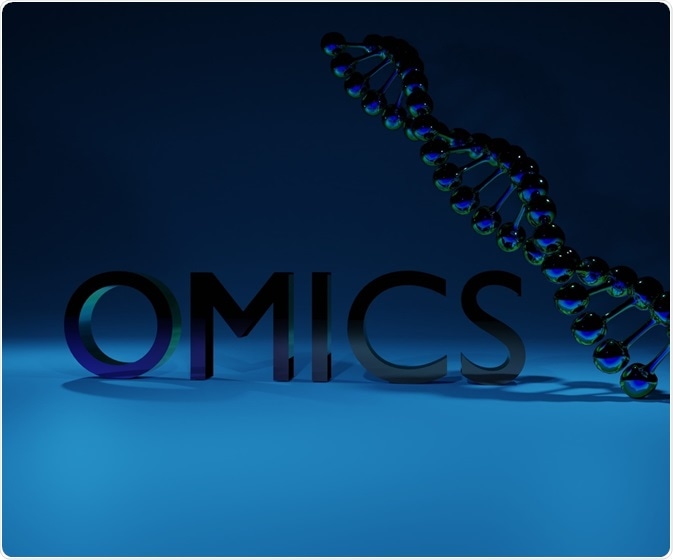The term “omics” refers to a pool of technologies that are used to measure and functionally characterize different biomolecules in cells or tissues. The primary aim of “omics” technologies is to study genes (genomics), RNAs (transcriptomics), proteins (proteomics), and metabolites (metabolomics).

Image Credit: Love Employee/Shutterstock.com
What is genomics?
Genomics is the study of the whole genome (the complete set of DNA) of an organism. In this particular field of biology, structural and functional characterization of the genome is performed using a combination of recombinant DNA, DNA sequencing and mapping methods, and bioinformatics.
Functional genomics primarily focuses on studying the involvement of genes or intergenic regions (DNA sequences located between genes) in shaping different biological activities. The main aim is to assess differential expressions of genes in a specific condition, such as during the development and progression of diseases.
Functional genomics utilizes several specific approaches to link a particular genotype to a particular phenotype, including genomics and epigenomics, transcriptomics, proteomics, and metabolomics. The integration of findings obtained from these approaches can generate a complete model of a given biological system.
What is transcriptomics?
Transcriptomics is the study of gene expression and function in cells or tissues. The transcriptome refers to a complete set of RNAs that are produced from the genome. RNA is the intermediary biomolecule that transfers information stored in genomic DNA to proteins.
Thus, transcriptomics is the major link between genomics, proteomics, and metabolomics. In transcriptomics, all forms of RNAs are studied, including protein-coding and non-coding RNAs, alternatively spliced, adenylated, or initiated RNAs, sense and antisense RNAs, and RNA-edited transcripts.
Microarray technology is widely used to study known RNA sequences. The advancement in high-throughput RNA-sequencing technologies has made it possible to study the expression of multiple sequences simultaneously in different physiological and pathological conditions. This is vital for identifying transcriptomic changes associated with particular phenotypes in living organisms.
What is proteomics?
Proteomics is the study of protein structure, function, and interactions in cells. The genetic information stored in mRNA is used to synthesis proteins. The process is called translation. Each gene in the genome can encode multiple variants of a protein.
Each of the variants subsequently undergoes posttranslational modifications to gain distinct properties. Thus, proteomics allows for studying multiple unique protein targets, which is vital for studying disease biology and identifying therapeutic and diagnostic biomarkers.
Mass spectrometry is the most widely used method in proteomics, in addition to gel-based methods. Recently, high-resolution cryo-electron microscopy methods are gaining importance for structurally characterizing proteins in native states both ex vivo and within cells.
What is metabolomics?
Metabolomics is the study of substrates, final products, and secondary products of metabolism, which are collectively known as metabolites. The term “metabolome” is used to define these metabolites (glucose, lipid, amino acid, fatty acid, alkaloids, phenolic compounds, etc.) and their interactions within a biological system.
The metabolome within a cell is highly dynamic because of the continuous synthesis, absorption, and degradation of metabolites. Thus, the levels of metabolites at a given time directly reflect the biochemical activity of cells or tissues.
“Omics” technologies in healthcare
Omics technologies, collectively, have made it possible to study the genetic makeup of an individual. This in turn has contributed immensely to developing personalized medicines. Proper integration of data collected from individual omics technologies, including genomics and epigenomics, transcriptomics, proteomics, and metabolomics, can lead to the development of a complete biological system that can be cultivated further to inform several basic bioscience or clinical biology investigations.
The high-quality representative human genome sequence obtained from the Human Genome Project has been successfully used in a wide range of biomedical studies, such as the investigation of genetic mutations responsible for neoplastic transformation or genetic risk factors of specific diseases.
Omics-based assays can be used to study the complex interactions between multiple genetic and environmental factors that occur during the pathogenesis of severe diseases, including cancers, diabetes, cardiovascular diseases, etc. Such information is particularly required to develop diagnostic and therapeutic approaches, as well as to study the clinical efficacy of specific drugs.
Regarding drug discovery and development, omics technologies have contributed significantly in identifying and selecting the most potent targets and exploring their interactions at the DNA, RNA, and protein levels. In different cancer types, the identification of overexpressed growth factor-encoding genes has resulted in the discovery of more targeted therapeutic interventions, such as monoclonal antibodies.
Meta-analysis of pre-existing data obtained from different genomic databases has made it possible to identify minute but biologically distinct and relevant events that occur in a specific subset of a given population. Such information is particularly important to identify community-level susceptibility to a particular disease or allergies to a particular drug.
The development of bacterial resistance due to the excessive use of antibiotics has become a significant public health crisis. Many plant-derived compounds with anti-bacterial properties have been identified and are currently under clinical investigation to overcome this crisis. Omics technologies have contributed significantly to investigating the mode of action, functional and structural properties, and metabolism of natural compounds in target cells.
References:
Further Reading